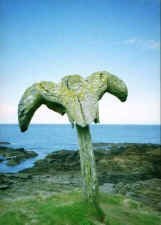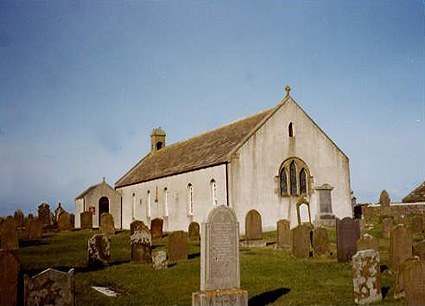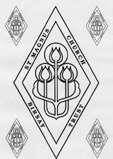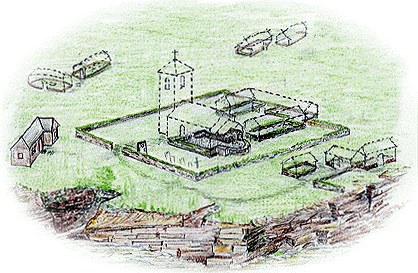| The Home website of the BIRSAY HERITAGE TRUST Home | Barony Mills | St. Magnus Church | Directory | Historic Sites | Scenic Walks | HMS Tern | Orkney Flours Project | "Roond Aboot Birsay" | Membership |
BirsayAncient Capital of
Orkney
|
| 1) The Whale Bone (see inset), Fishermen's Huts and Northside Cliffs Link |  The Whale Bone |
| 2) Brough Head Lighthouse and sea bird colonies (access at low tide only) Link | |
| 3) Kitchener's Memorial and Marwick Head Link | |
|
4) The Loons, RSPB wet-land reserve Link |
|
|
5) Loch of Boardhouse, boats and fishing Link |
|
| 6) Marwick Bay and Choin Link | |
| 7) Peat Hills and moorland |
Alliance, religion, bribery, intrigue, treason, murder - ingredients of power struggle and misrule in the Europe of the Reformation - did, indeed, bring suffering to Orcadians. Around 1565, Robert Stewart, illegitimate son of James V, was granted rule of Orkney (and Shetland) by Mary, Queen of Scots; recognition of the grants did not go unchallenged. Earl Robert spent most of his time on Orkney building his power base. While his forces occupied the castle in Kirkwall and later in Westray, his main residence would have been his Palace in Birsay, built c.1574.
Now only a picturesque ruin, descriptions and inventories of the time testify to the sumptuous quarters that the palace provided. One can imagine the colour and pageantry of the Earl's residence, and also the pain and hardship wrought by an unjust Ruler.
Maintained by Historic Scotland. Open at all times (no fee)
St Magnus Church, Birsay stands on the site of a much older church, in existence long before St Magnus Cathedral in Kirkwall. It is now accepted that St Magnus Church stands at least partly on the site of the original Christchurch built by Earl Thorfinn c. 1064. Thus the site has been in continuous use a place of worship for over 900 years, first as dyrligt musteri (a splendid minster) and then as the parish church. Joseph Anderson, who edited The Orkneyinga Saga, in 1873, assures us that this church was still referred to by the local people as 'the Christ's Kirk'.
After the murder of Magnus Erlendson in Egilsay, c. 1116, his body was brought to Thorfinn's Christchurch for burial. Soon there were stories of 'heavenly lights and a strange fragrance' surrounding his grave. This was followed by many pilgrimages and stories of visions and miracles. Twenty years after his death, Magnus' body was exhumed and his bones were placed in a shrine above the high altar in Christchurch. He was officially declared a saint, but times were changing. A large cathedral was built in Kirkwall to venerate the new saint and his bones were taken and interred there. The little church in Birsay was no longer the most important church in the Earldom.
Christchurch continued to serve the people of Birsay. In 1664 it was re-built as a cruciform church (shown in a 17th century drawing of the Earl's Palace which is reproduced on p.83 in Exploring Scotland's Heritage - Orkney and Shetland - Anna Ritchie, HMSO 1985). The church was again re-built in 1760 as a simple rectangular church, and in 1867 enlarged and restored. While the building was being restored in the 1980's the stonework clearly showed the different phases of construction. Huge blocks of red sandstone formed the foundations at the south-east end of the church, an indication that this had been the site of a very important medieval church.
In 1875 a larger church was built in the parish at Twatt. However, the former Christchurch (now called St Magnus) continued to be a regular place of worship. In 1996 the Church of Scotland recognised that they could no longer support both the Twatt church and St Magnus Church. Thus, St Magnus Church was scheduled for closure. A Trust was formed and an historic step was taken. The Church of Scotland handed over the church to the Trust, who now have the responsibility of maintaining the church.
The rebuilt church incorporates some features of the earlier structures, including the 17th century belfry and a 13th century lancet window. In the base of this window is a broken lintel with the inscription ' S BELLUS'. The first part of the inscription 'MON(S)' is built into the window surround of the farm to the north of the church. This must have come from the residence of the 16th century bishops of Orkney, MONS BELLUS, which is known to have been nearby.
When the floor of the church was taken up during alterations in the early 1900s, two very old gravestones were found. One is now beside the pulpit. The inscriptions are now illegible, but there is a rough coat-of-arms and the date 1645. The other stone stands in the vestibule. The stained glass window installed shortly after 1900 was designed by Mrs. McPherson, wife of the minister, and made by Alex Strachan, whose brother designed and made one of the windows for St Magnus Cathedral, Kirkwall.
In the walled churchyard can be found numerous interesting gravestones, particularly the recumbent ones to the left as you enter the church. The inscriptions on each of the gravestones are given a placement number so that they are easily located. It is interesting that each district of the parish seems to have been allotted a section of the graveyard, and the layout roughly follows the configuration of the parish, so that the Southside and Marwick families are buried on the south side of the church and families from the Northside are mainly buried on the north side.
The St Magnus Church Birsay Trust supports the fabric of the church through donations and the sale of jewellery specially designed and made for them by Orkneyinga Silversmiths.
The church is open to view every day (year round). A key to the church can be obtained from the shop in the village. We invite you to come to the village called The Palace and enjoy the serenity of this historic church adjacent to the sea. When you leave, we hope that you will take with you a sense of the importance Birsay held as a 'capital of the Vikings'.
Sketches by Harold Stanley
For centuries, political and religious power radiated from this small scenic tidal island and the adjacent bay shore. Influence was at its height during the reign of Thorfinn the Mighty (1014-1065) when this Earl of Orkney's rule extended from Shetland down the west coast of Scotland to parts of Ireland. Thorfinn's main residence was in Birsay according to the Sagas, and the remains of elaborate buildings on the Brough of Birsay are thought to be Thorfinn's headquarters. At this time, the first Bishop of Orkney was appointed and his cathedral was probably on the site of the present St Magnus Church, according to recent scholarship.
On the Brough there are remains of a fine Romanesque church and ecclesiastical buildings - probably a monastery associated with the Bishop's See. Interestingly enough, this church is built on the remains of a Pictish church some 300 years older - before Christianity was wiped out by the Vikings in the eighth century. The famous, but enigmatic symbol stone found in the earlier graveyard on the Brough shows Pictish symbols and three warriors - noblemen. Was their capital here also? Historic Scotland maintains a small site museum on the Brough, only a short walk at low tide from the Point of Buckquoy.
Click Mill
This is the last working example of a horizontal water-mill left in Orkney. The 'click mill' was so named because of the sound it made whilst running, and it is the most primitive type of water-powered mill known in Britain. It is a simple, mechanised version of the hand quern, and is turned by the water acting on a wooden wheel or 'tirl', which is connected directly to the topmost of the two stones






